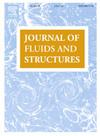可调隐蔽启发流量控制:实验和基于模型的调查
IF 3.4
2区 工程技术
Q1 ENGINEERING, MECHANICAL
引用次数: 0
摘要
鸟类上翼护羽是在大攻角机动中被动展开的轮廓羽毛。本研究研究了在Re= 200000时被动式折叠式扭转铰接襟翼的动力学,评估了其对周围流场的影响以及由此产生的气动性能。首先,研究表明,扭转铰接襟翼能有效缓解失速后迎角α=24°时的气流分离,最多可提高22%升力,减少7%阻力。其次,一个新建立的分析模型的结果表明,襟翼的振荡频率取决于其前方的局部流速,并且随着襟翼位置的变化而显著变化。经历低局地速度的尾缘襟翼以其结构固有频率振荡。同时,由于气动诱导的附加刚度,高局域速度的前缘襟翼振荡频率高于其固有频率。襟翼的动力学也取决于气流的能谱,其中有效振荡频率较低的襟翼表现出较高的波动,因为它们与气流的高能频段相吻合。最后,通过改变襟翼的惯量和铰链刚度来调整其平均位置和波动,以增强襟翼所采用的流量控制机制。例如,尾缘襟翼通过充当压力坝来增强升力,当襟翼垂直于翼型表面时,其效率最高。另一方面,前缘襟翼通过减少不利的几何压力梯度来提高升力,当襟翼以最小的波动与剪切层相互作用时,气动效益最大化。这篇文章提供了一个基于物理的框架,以增强我们对秘密启发皮瓣的理解。这些知识可以为各种工程应用的被动和自适应流量控制策略的设计提供信息。本文章由计算机程序翻译,如有差异,请以英文原文为准。
Tunable covert-inspired flow control: An experimental and model-based investigation
Bird upperwing coverts are contour feathers observed to passively deploy during high angle of attack maneuvers. This study investigates the dynamics of passive covert-inspired torsionally hinged flaps at , assessing their impact on the surrounding flow field and the resulting aerodynamic performance. First, the study shows that the torsionally hinged flaps effectively mitigate flow separation at a post-stall angle of attack with up to 22% lift improvements and 7% drag reduction. Second, results from a newly developed analytical model reveal that the flap’s oscillation frequency depends on the local flow velocity ahead of it and varies significantly as a function of the flap location. Trailing-edge flaps that experience low local velocities oscillate at their structural natural frequency. Meanwhile, leading-edge flaps with higher local velocity oscillate at a higher frequency than their natural frequency due to the aerodynamically induced added stiffness. The flap dynamics also depend on the energy spectrum of the flow, where flaps with lower effective oscillation frequencies exhibit higher fluctuations because they coincide with the flow’s high-energy frequency band. Finally, varying the flap’s inertia and hinge stiffness tunes its mean position and fluctuations to enhance the flow control mechanism employed by the flap. For instance, trailing-edge flaps enhance lift by acting as a pressure dam, with maximum effectiveness when the flap is perpendicular to the airfoil’s surface. Leading-edge flaps, on the other hand, improve lift by reducing adverse geometric pressure gradients, with maximum aerodynamic benefits occurring when the flap interacts with the shear layer with minimal fluctuations. This article provides a physics-based framework to enhance our understanding of covert-inspired flaps. Such knowledge can inform the design of passive and adaptive flow control strategies for various engineering applications.
求助全文
通过发布文献求助,成功后即可免费获取论文全文。
去求助
来源期刊

Journal of Fluids and Structures
工程技术-工程:机械
CiteScore
6.90
自引率
8.30%
发文量
173
审稿时长
65 days
期刊介绍:
The Journal of Fluids and Structures serves as a focal point and a forum for the exchange of ideas, for the many kinds of specialists and practitioners concerned with fluid–structure interactions and the dynamics of systems related thereto, in any field. One of its aims is to foster the cross–fertilization of ideas, methods and techniques in the various disciplines involved.
The journal publishes papers that present original and significant contributions on all aspects of the mechanical interactions between fluids and solids, regardless of scale.
 求助内容:
求助内容: 应助结果提醒方式:
应助结果提醒方式:


